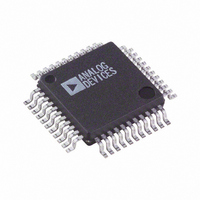AD7865BSZ-1 Analog Devices Inc, AD7865BSZ-1 Datasheet - Page 18

AD7865BSZ-1
Manufacturer Part Number
AD7865BSZ-1
Description
4 CH. SIMULTANEOUS BIPOLAR,14-B ADC I.C.
Manufacturer
Analog Devices Inc
Datasheet
1.AD7865AS-2REEL.pdf
(19 pages)
Specifications of AD7865BSZ-1
Number Of Bits
14
Sampling Rate (per Second)
350k
Data Interface
Parallel
Number Of Converters
1
Power Dissipation (max)
160mW
Voltage Supply Source
Analog and Digital
Operating Temperature
-40°C ~ 85°C
Mounting Type
Surface Mount
Package / Case
44-MQFP, 44-PQFP
Lead Free Status / RoHS Status
Lead free / RoHS Compliant
Available stocks
Company
Part Number
Manufacturer
Quantity
Price
Company:
Part Number:
AD7865BSZ-1
Manufacturer:
ADI
Quantity:
364
Company:
Part Number:
AD7865BSZ-1
Manufacturer:
Analog Devices Inc
Quantity:
10 000
Part Number:
AD7865BSZ-1
Manufacturer:
ADI/亚德诺
Quantity:
20 000
Company:
Part Number:
AD7865BSZ-1REEL
Manufacturer:
Analog Devices Inc
Quantity:
10 000
AD7865
The MC68000 AS and R/W outputs are used to generate a
separate RD input signal for the AD7865. CS is used to drive
the 68000 DTACK input to allow the processor to execute a
normal read operation to the AD7865. The conversion results
are read using the following 68000 instruction:
where D0 is the 68000 D0 register and ADC is the AD7865
address.
Vector Motor Control
The current drawn by a motor can be split into two compo-
nents: one produces torque and the other produces magnetic
flux. For optimal performance of the motor, these two compo-
nents should be controlled independently. In conventional
methods of controlling a three-phase motor, the current (or
voltage) supplied to the motor and the frequency of the drive are
the basic control variables. However, both the torque and flux
are functions of current (or voltage) and frequency. This cou-
pling effect can reduce the performance of the motor because,
for example, if the torque is increased by increasing the fre-
quency, the flux tends to decrease.
Vector control of an ac motor involves controlling phase in
addition to drive and current frequency. Controlling the phase
of the motor requires feedback information on the position of
the rotor relative to the rotating magnetic field in the motor.
Using this information, a vector controller mathematically trans-
forms the three phase drive currents into separate torque and
flux components. The AD7865, with its four-channel simulta-
neous sampling capability, is ideally suited for use in vector
motor control applications.
A block diagram of a vector motor control application using the
AD7865 is shown in Figure 22. The position of the field is
derived by determining the current in each phase of the motor.
Only two phase currents need to be measured because the third
can be calculated if two phases are known. V
AD7865 are used to digitize this information.
Simultaneous sampling is critical to maintain the relative phase
information between the two channels. A current sensing isola-
tion amplifier, transformer or Hall-effect sensor is used between
the motor and the AD7865. Rotor information is obtained by
measuring the voltage from two of the inputs to the motor. V
and V
IN4
of the AD7865 are used to obtain this information.
V
V
V
V
IN1
IN2
IN3
IN4
AD7865
DB0–DB13
CONVST
RD
CS
MOVE.W ADC,D0
ADDRESS
DECODE
CLOCK
IN1
A0–A15
DTACK
AS
R/W
D0–D13
and V
MC68000
IN2
of the
IN3
Once again, the relative phase of the two channels is important.
A DSP microprocessor is used to perform the mathematical
transformations and control loop calculations on the informa-
tion fed back by the AD7865.
MULTIPLE AD7865s IN A SYSTEM
Figure 23 shows a system where a number of AD7865s can be
configured to handle multiple input channels. This type of con-
figuration is common in applications such as sonar, radar, etc.
The AD7865 is specified with maximum limits on aperture
delay match. This means that the user knows the difference in
the sampling instant between all channels. This allows the user
to maintain relative phase information between the different
channels. The AD7865 has a maximum aperture delay match-
ing of ± 4 ns.
All AD7865s use the same external SAR clock (5 MHz). There-
fore, the conversion time for all devices will be the same and so
all devices may be read simultaneously. In the example shown in
Figure 23, the data outputs of two AD7865s are enabled onto a
32-bit wide data bus when EOC goes low.
SETPOINT
SETPOINT
TORQUE
FLUX
ADDITIONAL PINS OMITTED FOR CLARITY
AD780
5MHz
DSP MICROPROCESSOR
PHASE INFORMATION
CALCULATIONS AND
TORQUE AND FLUX
TRANSFORMATION
TWO-TO-THREE-
TO TORQUE AND
CONTROL LOOP
FLUX CURRENT
COMPONENTS
V
V
V
V
V
V
V
V
V
CLK IN
V
CLK IN
IN1
IN2
IN3
IN4
IN1
IN2
IN3
IN4
REF
REF
AD7865
AD7865
EOC
RD
CS
RD
CS
14
DAC
DAC
DAC
14
AD7865
V
V
V
V
CIRCUITRY
IN1
IN2
IN3
IN4
AMPLIFIERS
32
ISOLATION
DRIVE
ATTENUATORS
VOLTAGE
RD
ADSP-2106x
ADDRESS
DECODE
I
I
I
C
B
A
V
B
V
A
MOTOR
PHASE
3-













